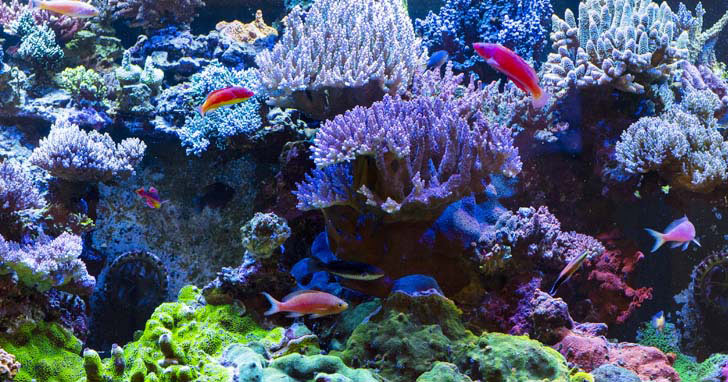
Factors that Influence Coral ColorationThere are many environmental reasons why corals may change color. However, in home reef aquariums, the most common cause of dramatic color change is due to aquarium lighting. Corals react to light by adjusting the number of cells responsible for utilizing light, as well as the pigments that provide protection from strong light. What we perceive as color change is, in fact, the coral's natural response to a particular light source. Corals will strive to achieve a balance where the number of cells and amount of pigment matches the coral’s needs for both nutrition and protection. Light intensity and coral color
Many corals have the ability to adapt to different light intensities. For example, photosynthetic corals have special light sensitive cells called zooxanthellae cells. These symbiotic cells contain chlorophyll and provide nutrients to the coral in exchange for protection. To ensure a continuous source of necessary nutrients, the host coral regulates the number of zooxanthellae cells and amount of chlorophyll within those cells. One of the basic criteria for zooxanthellae cells and chlorophyll regulation is light intensity. If the light is more intense than what the coral is accustomed to, then one of two things will occur. Either some zooxanthellae cells will be expelled from the coral or the amount of chlorophyll within those cells will be reduced. Having excess zooxanthellae cells in a brightly lit environment can be dangerous to corals. Under intense light, oxygen generated as a by-product of zooxanthellae photosynthesis can accumulate to toxic concentrations within the coral. In contrast, if light intensity is lower than what the coral usually receives, the photosynthetic zooxanthellae cells will not be able to produce a sufficient amount of nutrients for the host coral. Subsequently, the number of zooxanthellae cells, as well as the amount of chlorophyll within those cells, will increase in an effort to capture more light energy. So how do zooxanthellae cells and chlorophyll concentration affect coral coloration? Zooxanthellae cells range in color from golden-yellow to brown and large numbers of these cells give the coral a brown appearance. In other words, light intensity alters the color of photosynthetic corals by affecting the concentration of both zooxanthellae cells and the amount of chlorophyll present within those cells. Therefore, in less intense lighting conditions, photosynthetic corals will appear darker brown since the corals host more zooxanthellae cells to produce more nutrients. If the same coral is placed under intense lighting, zooxanthellae cells will be expelled, and the reduced amount of chlorophyll will give the coral a lighter appearance. Color change due to light spectrum
The light spectrum, or color temperature, of aquarium lighting will also alter the appearance of corals. In general, light with lower Kelvin ratings will appear "warmer" while light with higher Kelvin ratings will appear bright white to blue. Different light fixtures with different output impart varying color effects on corals. For example, light heavy in the actinic blue range brings out dazzling fluorescent colors not visible under full spectrum lighting. While different hobbyists prefer different combinations of light spectrums, a typical lighting system for a reef aquarium consists of 50% white light with a high Kelvin rating and 50% blue, actinic light. Color change due to UV light
In nature, ultraviolet light waves (UV-A and UV-B) penetrate the ocean's surface but are filtered out as the light travels through the water. Both UV-A and UV-B light waves have been found to cause destruction of DNA and RNA within coral tissue. In response, many corals have made adaptations to reduce the effects of these harmful rays. These corals developed protective pigments that are often blue, purple, or pink in color. Most corals that contain these pigments come from shallow waters where the amount of UV-A and UV-B light is higher than in deeper areas of the reef. In home reef aquariums that rely on metal halide lighting, it is important to protect corals from UV light. Coral without these protective pigments as well as shallow water corals that may have lost their pigments during transportation are especially susceptible to the effects of UV light. Fortunately, preventing any UV light from entering the aquarium is as simple as employing aquarium canopies and making sure the protective glass lens on the metal halide fixture is properly installed. It is not uncommon for corals with these bright colors to adjust to the lower UV-A and UV-B conditions found within home aquariums. The loss of colorful pigmentation is not necessarily a sign of an unhealthy coral - it is simply a normal coral adjusting to its new environment. Do color changes in my new coral mean something’s wrong?
It is a common misconception among many hobbyists that color changes in newly received coral is an indication of an unhealthy coral. Many times, the color change is merely the result of corals adjusting to the new lighting intensity, spectrum, and change in UV light. With this in mind, it is important to consider the color of newly received corals and understand their lighting requirements. Be sure to properly acclimate corals to new lighting conditions and allow time for them to establish their coloration. Question :
My new coral is starting to look a bit faded. What's going on? Anwser :
Test water parameters to see if everything is within an acceptable range for your particular species. Also, photosynthetic corals need time to acclimate to new lighting conditions. Allow your coral to adjust to its new home and gradually alter its position to ensure proper light levels References and Further Reading Related Articles
|
|
|


